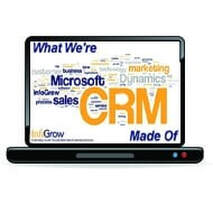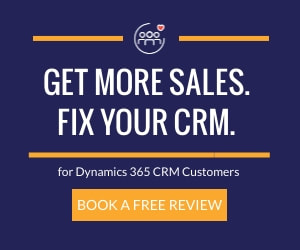See your organization thrive! Improve the customer experience by keeping your sales, marketing
and customer service teams on the same page.
and customer service teams on the same page.
�
 Most software ROI calculations are built off of two tenets: sell more or cut costs. The problem that most organizations run into is that they have no solid numbers to address either; “sell how much more”, or “save how much time” can be elusive concepts. I suggest that there are three fundamental business objectives that sales, marketing, and service must focus on and can be used to justify a Dynamics CRM system: 1) find more customers like our best ones, 2) keep the ones we want, and 3) increase profitable transactions.  Dear Bob, As a national sales manager, I have a full-time job already. While recognizing that using a CRM is an evolving tool where users need to be given direction and and behaviors that I want must be monitored, I am just not finding the additional time in my day. I tend to only focus on how Dynamics is working just before each quarterly sales meeting. In that sales meeting, I bark out directives on how we are going to start using the tool more effectively. What should I be doing different? - Jon Dear Jon,
Your first step is to change your mindset about how you and your team use Dynamics CRM. It is not an add-on task for you or your team. Rather it is your primary sales process and management tool. Dear Bob, Where can I get the latest insights as to what changes and enhancements are coming down for Dynamics 365 CRM? - Jackie Dear Jackie,
We maintain a video library on our website - check out the Dynamics 365 CRM Coming Soon tab. Dear Bob, I have a client asking me what is difference between a free CRM system and Dynamics? Since free is always good - how do I provide him with guidance? -- Phil, MSP Dear Phil,
For getting started, the simple answer is that any CRM will do. A CRM system is like a young child. At first, the focus is just getting the child to talk and walk. Long term, however, you want them to mature, learning and do more. As your client moves to do more, mature with their CRM system, that is where a basic tool and more advance tool quickly separate. Dear Bob, My CFO is asking if our Dynamics CRM deployment was worth the cost. We are in year three of our use of Dynamics and I was not here for the decision to purchase. How do I respond? -- Jack, New Sales Manager Dear Jack,
Since you were not part of the decision process it will be difficult for you collect all of the deployment cost to build your case. I therefore suggest using a combination of the following approaches: Dear Bob, I have a client with an older copy of Goldmine that they just have outgrown. I am afraid to outsource what I don’t know and risk the relationship. -- Mike Dear Mike,
Don’t be afraid to partner. Don’t be afraid to tell your client that CRM is not your specialty, however, you have the capability to bring in someone who is an expert. And together, we can work with you to provide the best possible solution. Change is inevitable – but how do you keep evolving? Today's CRM (Customer Relationship Management) is better than yesterday's because: (a) CRM systems such as Microsoft Dynamics 365 CRM can now deliver greater productivity returns and (b) vendors' software usability is much improved. These advancements (and others) mean less time and lower costs to implement a CRM system. And the more people in a given company who use a CRM system translates to more benefits and a higher ROI on a CRM investment. Research notes that for every dollar a company invests in a CRM system, it earns $5.60.
But not everyone who has a CRM system is experiencing the expected return and, thus, some are even Microsoft Dynamics 365 CRM haters. It may depend on how you choose and implement your CRM system. To help you get the most from your CRM, here are some common mistakes and ways to avoid them. Marketing Automation software serves a company's marketing department beyond what a Dyanmics CRM system does, and a CRM system serves sales and other departments. When integrated, Marketing Automation and Dynamics 365 CRM tools enhance each other, resulting in even more and better-qualified leads and, ultimately, more sales and satisfied customers. If you have one of these productivity tools, here are reasons to have both, in a single, centrally located, easy to use, integrated system.
Most software ROI calculations are built off of two tenets: sell more or cut cost. The problem that most organizations run into is that they have no solid numbers to address either; “sell how much more”, or “save how much time” are elusive concepts.
I suggest that there are three fundamental business objectives that sales, marketing and service must focus on: find more customers like our best ones, keep the ones we want, and increase profitable transactions. The way to justify a Dynamics 365 CRM system is to start by asking: "What is the cost of inaction in effectively supporting and measuring progress associated with these three fundamental business objectives?" Leads can come in many ways; website, referral, trade show, direct mail, email drip and even an account rep prospecting. But if we don’t know the sales return from each or the cost of each, how do we evaluate where to invest a limited marketing budget?
Data Silos Bad for Your Clients’ Business -- 9 Reasons to Replace Excel Spreadsheets with CRM6/11/2018
Some B2B companies run their sales and marketing activities with Excel because it is easy to use and well known by employees. However, to more efficiently manage and profitably use data, other B2Bs use a relational-based CRM (Customer Relationship Management). A CRM consists of a database and a user-interface with which you can easily create, update, manage, process, share, and report data across the organization.
While Excel spreadsheets are great calculators, they are not good as a shareable database. That is because, in part, Excel has no relational tables and limited interface capabilities. Excel becomes cumbersome and difficult to manage with thousands of items. I was reminded this week of how much fun this business can be working with clients. As I met with three different clients on their Dynamics Roadmap for the next few quarters, it reminded me of why I am in this business of strengthening customer engagement.
Each of the clients has been with us for some time and each understand the value of CRM to the organization’s profitability and growth. However, it was good to hear that they also view CRM as a tool to strengthen a deeper relationship with their clients for all the various touch points that they have with the client. CRM is a tool to guide existing and new users in their behaviors while getting everyone in marketing, sales and customer service on the same page with the client needs. It’s not hard to see why your CRM data, made up of customers, prospects and influencers is your most important marketing asset. After all, how can a marketer be successful without the right data? And how can a marketer discover or fine tune a message without insight into behaviors and their service needs? But, keeping this data organized, current, and easily accessible for every relevant team member, throughout an organization, can still be a massive challenge.
I have written before regarding the sales growth value of getting your sales and marketing teams on the same page. This is an effort that can’t be left up to sales or marketing alone, it is too important to the organization and must be monitored at the CEO level.
InsideView does an excellence job in the following infographic to highlight what current leaders are doing to get things right. Point number 6 – “Align on Pipeline” is the element I like the most. By emphasizing the sales pipeline you should expect alignment on lead and nurturing campaigns throughout the sales process. This approach will help drive greater cohesion between both team leaders, as well as provide account reps with advanced insight into the contribution of the marketing team. Many companies don’t appreciate the value of a CRM system until they understand its pivotal role in closing more sales. CRM’s virtues are not always apparent unless one is intimate with the ins and outs of how business gets done in the organization.
Volumes have been written about customer engagement, which is an increasingly vital part of boosting sales, increasing membership, and satisfying both customers and prospects. While successful customer engagement requires a multi-level strategy, it doesn’t have to be complex... just thoughtful and complete.
You’ve seen the ads. The CRM software is free, forever or on a trial basis. Installation takes seconds. Learning takes minutes. Enter some contacts, play around with reports, and voilà! Within hours, everyone is tracking leads, analyzing pipelines, and monitoring customer interaction.
CRM can provide significant benefits to any sales-driven organization that’s focused on customer service. And it can have a profoundly positive impact on internal processes and performance, both individually and organizationally. Despite CRM’s inherent ability to boost profits and deliver insights, there are some things that CRM simply can’t do on its own.
|
HOME | SERVICES | SOLUTIONS | BLOG | WHY INFOGROW | CONTACT US |
Address2140 Front Street
Cuyahoga Falls, OH 44221 |
Telephone |
|
© 2024 InfoGrow Corporation











